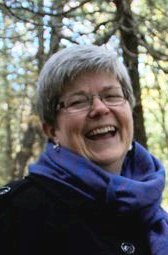A New Era for DLSPH and the WHO’s Collaborating Centre on Health Promotion
May 7/2021
DLSPH’s Centre for Global Health has just been named a WHO Collaborating Centre on Health Promotion – part of a network of 800 academic and research institutions that support the organization’s mission to improve the world’s health.
Although the School has been a Collaborating Centre since the 1990s, moving the designation into global health is a new and exciting opportunity for the nascent Centre for Global Health. Collaborating Centre co-directors Assoc. Prof. Erica Di Ruggiero (who is also director of the Centre for Global Health) and Suzanne Jackson talked to writer Heidi Singer about the significance of the designation, and the importance of transnational health promotion efforts during the pandemic and beyond.

Assoc. Prof. Erica Di Ruggiero
What does this particular link to WHO mean for us as a School?
Jackson: It’s really positive for our School and for the Centre for Global Health. The opportunity to influence what is going on across the Americas is exciting. The Pan-American Health Organization (PAHO) is our home region for the WHO so while we do link to the central office in Geneva, for health promotion, we mainly link to PAHO, which has been around even longer than WHO. It was created more than a century ago and is the largest most organized region in WHO. They create training materials, policy advice, and they’re interested in being connected to the latest research so they can react quickly and deal with issues across the Americas. Students have the opportunity to work on exciting projects through PAHO.
Di Ruggiero: Health promotion has fallen on and off the agenda over the decades. This provides a unique opportunity to reclaim and push the field forward. Canada has always been seen globally as a leader in health promotion but we haven’t always maintained the position. Very influential policy and programming has come out of Canada and the Collaborating Centre has helped to galvanize this.

Assoc. Prof. Suzanne Jackson
How will this relationship help the fight against COVID?
Jackson: Collaborating centres create guiding documents and training materials, they turn research into policy advice. We’re not in the business of actually implementing the kinds of changes that are needed. But this intelligence network of 183 collaborating centres in the Americas is a real asset for PAHO to figure out how to move forward. At a recent PAHO meeting we noticed that people could see they were connected across topics and centres. Collaborating Centres focused on labor and occupational health saw they needed to be in meetings with those focused on urban health and social determinants of health. All of us have perspectives and something to contribute in the post-pandemic era.
I’ve been involved in creating a virtual course in health promotion with colleagues from Latin America since 2015. The first version is available through PAHO’s virtual campus, which provides accessible training across the Americas. We’ve included a fictional case study about how communities have responded to COVID, drawing on examples from community actions during the pandemic in Toronto. Along with Prof. Blake Poland and the Centre for Connected Communities, we interviewed 46 grassroots leaders and talked to them about what they had done during the first wave of the pandemic, what helped and hindered their actions. People stepped up and brought their knowledge and contacts in the community, in order to connect to people, find out what they needed, how they deal with isolation, and the need for food. This research provided lots of examples that integrated all of the elements of health promotion covered in the virtual course.
Di Ruggiero: While the pandemic has understandably been dominated by infectious disease epidemiology, health promotion highlights how we need to strengthen communities, create supportive environments and identify healthy public policies in all sectors, with a particular focus on health equity. The Collaborating Centre provides that opportunity, which is so necessary during COVID, to identify the health impacts of other sectors where health isn’t the primary focus like housing, education and labour.
Jackson: It’s an opportunity to tap into work WHO has already done in supporting the healthy settings network, which brings health promotion to schools, municipalities, hospitals, and other settings worldwide. They have a huge Healthy Schools Network globally that looks at putting health promotion into the curriculum but also how the school’s environment (social and physical) affects health. Same with Healthy Cities, Healthy Hospitals, etc. In Health Promotion, we understand what it means to consider health in all policies and work across sectors. This helps us to understand how to respond to COVID across several sectors.
How will the Collaborating Centre work with the UN’s Sustainable Development Goals (SDGs)?
Jackson: We already connect to most of them.
Di Ruggiero: We can’t continue to address problems like COVID, housing, food insecurity one ministry or sector at a time, one health issue at a time. The SDGs are a call for strategies that cut across those issues, and these will also help with pandemic prevention. How do we build resilient economic and social structures influenced by health promotion and other areas? We need to put attention on social and health inequities in a very meaningful way whether we’re addressing economic resiliency, pandemic readiness or climate change.
What is the history of health promotion at U of T?
Jackson: U of T was the first campus in Canada with a Master of Health Science focused on health promotion, starting in the 1980s. We recognized the definition of health promotion is very broad – not about promoting healthy behaviours but helping people to take control of their health. Irv Rootman was director of the Centre for Health Promotion, which set up the Ontario Tobacco Unit, the Health Communication Unit, the Centre for Quality of Life and received the first designation as a WHO Collaborating Centre. I was director from 2001 to 2009 and continued as Director of the Collaborating Centre in Health Promotion until 2019.
Di Ruggiero: Global health and health promotion are natural partners. To have this health promotion initiative live within CGH was well received at PAHO. The Ottawa Charter for Health Promotion, created in 1986 sponsored by WHO, put forward a definition of health promotion that is known and practised globally. The healthy settings network that encompass the full understanding of health promotion are global movements. The Centre for Global Health, with its focus on health equity, social determinants of health, universal health coverage, and development for sustainability is a perfect home for a movement with the same values.